Monographs
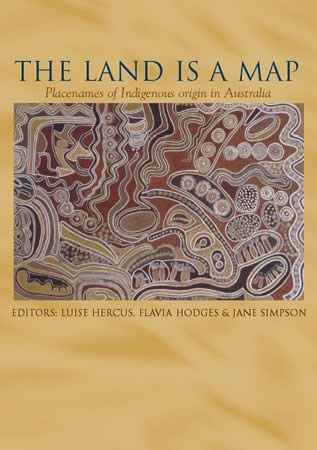
The land is a map: placenames of Indigenous origin in Australia.
Edited by Luise Hercus, Flavia Hodges & Jane Simpson.
Canberra: Pandanus Books / ANU Research School of Pacific & Asian Studies, 2002.
ISBN 1-74076-020-4
The entire Australian continent was once covered with networks of Indigenous placenames. These names often evoke important information about features of the environment and their place in Indigenous systems of knowledge. On the other hand, placenames assigned by European settlers and officials are largely arbitrary, except for occasional descriptive labels such as 'river, lake, mountain'. They typically commemorate people, or unrelated places in the Northern Hemisphere.
In areas where Indigenous societies remain relatively intact, thousands of Indigenous placenames are used but have no official recognition. Little is known about any variation in principles of placename bestowal found in different Indigenous groups. While many Indigenous placenames have been taken into the official placename system, they are often given to different features from those which they originally applied to. In the process, they have been cut off from any understanding of their original meanings. Attempts are now being made to ensure that additions of Indigenous placenames to the system of official placenames more accurately reflect the traditions they come from.
This book ranges across all these issues. The contributors bring a wide range of different experiences, both academic and practical, to their contributions. The book promises to be a standard reference work on Indigenous placenames in Australia for many years to come.
The Land is a Map was launched in Canberra on 5 December 2002 at the Australian Placenames Colloquium. The book is available from ANU Press: print - $50, download - free.

Aboriginal placenames: Naming and re-naming the Australian landscape.
Edited by Harold Koch & Luise Hercus.
Canberra: ANU Press, 2009.
ISBN 9781921666087
ISBN 9781921666094 (online)
Aboriginal approaches to the naming of places across Australia differ radically from the official introduced Anglo-Australian system. However, many of these earlier names have been incorporated into contemporary nomenclature, with considerable reinterpretations of their function and form. Recently, state jurisdictions have encouraged the adoption of a greater number of Indigenous names, sometimes alongside the accepted Anglo-Australian terms, around Sydney Harbour, for example. In some cases, the use of an introduced name, such as Gove, has been contested by local Indigenous people.
The 19 studies brought together in this book present an overview of current issues involving Indigenous placenames across the whole of Australia, drawing on the disciplines of geography, linguistics, history, and anthropology. They include meticulous studies of historical records, and perspectives stemming from contemporary Indigenous communities. The book includes a wealth of documentary information on some 400 specific placenames, including those of Sydney Harbour, the Blue Mountains, Canberra, western Victoria, the Lake Eyre district, the Victoria River District, and southwestern Cape York Peninsula. The book is available from ANU Press: print - $48, download - free.

The land is a map: placenames of Indigenous origin in Australia.
Edited by Luise Hercus, Flavia Hodges & Jane Simpson.
Canberra: Pandanus Books / ANU Research School of Pacific & Asian Studies, 2002.
ISBN 1-74076-020-4
The entire Australian continent was once covered with networks of Indigenous placenames. These names often evoke important information about features of the environment and their place in Indigenous systems of knowledge. On the other hand, placenames assigned by European settlers and officials are largely arbitrary, except for occasional descriptive labels such as 'river, lake, mountain'. They typically commemorate people, or unrelated places in the Northern Hemisphere.
In areas where Indigenous societies remain relatively intact, thousands of Indigenous placenames are used but have no official recognition. Little is known about any variation in principles of placename bestowal found in different Indigenous groups. While many Indigenous placenames have been taken into the official placename system, they are often given to different features from those which they originally applied to. In the process, they have been cut off from any understanding of their original meanings. Attempts are now being made to ensure that additions of Indigenous placenames to the system of official placenames more accurately reflect the traditions they come from.
This book ranges across all these issues. The contributors bring a wide range of different experiences, both academic and practical, to their contributions. The book promises to be a standard reference work on Indigenous placenames in Australia for many years to come.
The Land is a Map was launched in Canberra on 5 December 2002 at the Australian Placenames Colloquium. The book is available from ANU Press: print - $50, download - free.

Aboriginal placenames: Naming and re-naming the Australian landscape.
Edited by Harold Koch & Luise Hercus.
Canberra: ANU Press, 2009.
ISBN 9781921666087
ISBN 9781921666094 (online)
Aboriginal approaches to the naming of places across Australia differ radically from the official introduced Anglo-Australian system. However, many of these earlier names have been incorporated into contemporary nomenclature, with considerable reinterpretations of their function and form. Recently, state jurisdictions have encouraged the adoption of a greater number of Indigenous names, sometimes alongside the accepted Anglo-Australian terms, around Sydney Harbour, for example. In some cases, the use of an introduced name, such as Gove, has been contested by local Indigenous people.
The 19 studies brought together in this book present an overview of current issues involving Indigenous placenames across the whole of Australia, drawing on the disciplines of geography, linguistics, history, and anthropology. They include meticulous studies of historical records, and perspectives stemming from contemporary Indigenous communities. The book includes a wealth of documentary information on some 400 specific placenames, including those of Sydney Harbour, the Blue Mountains, Canberra, western Victoria, the Lake Eyre district, the Victoria River District, and southwestern Cape York Peninsula. The book is available from ANU Press: print - $48, download - free.
Selected articles
William Metcalf 'Process in placenaming Southeast Brisbane' Papers - Brisbane History Group no 9 (1990), 93-101. [Available online]
Joshua Nash 'Is toponymy necessary?' Studies in Language vol 39, no 1 (2015), 229-234.
Jan Tent 'Approaches to research in toponymy' Names vol 63, no 2 (2015), 65-74.
Joshua Nash 'Island placenaming and insular toponymies' Names vol 63, no 3 (2015), 146-157.
Joshua Nash 'Placenames and ecolinguistics: some considerations for toponymists' Arbeiten aus Anglistik und Amerikanistik vol 40, no 1/2 (2015), 99-103.
Joshua Nash 'On the possibility of Pidgin English toponyms in Pacific missions' Historiographia Linguistica vol 42, no 1 (2015), 139-151.
Joshua Nash 'Language contact and "the Catch": Norfolk Island fishing ground names' Norsk Geografisk Tidsskrift - Norwegian Journal of Geography vol 70, no 1 (2016), 62-67. [Available from Routledge Informaworld]
Joshua Nash 'Do island toponymies exist?' Island Studies Journal vol 11, no 2 (2016), 339-342.
Joshua Nash 'Cultural aspects of Norfolk Island toponymy' Onomastica Canadiana vol 95, no 1/2 (2016), 23-49.
Jan Tent 'The ghosts of Christmas (Island) Past: An examination of its early charting and naming' Terrae Incognitae: the Journal of the Society for the History of Discoveries (2016), 1-23.
[Available from Taylor & Francis Online]
Jan Tent 'Antecedent generics: How capes, lakes, mounts, and points are named in the Antipodes' Names vol 64, no 3 (2016), 148-157. [Available from Taylor & Francis Online]
Joshua Nash 'Linguistics, geography, and the potential of Australian island toponymies' Australian Geographer vol 48 (2017). [Available from Taylor & Francis Online]
Jan Tent 'Indigenous toponyms in the Antipodes: a gazetteer-based study' Names vol 65, no 4 (2017), 204-214. [Available from Taylor & Francis Online]
Jan Tent and David Blair 'A Clash of names: the terminological morass of a toponym class' Names vol 66, no 1 (2018), 1-12. [Available from Taylor & Francis Online]
Jan Tent 'What's in a demonym? A note on a new and uplifting ethnonym.' Names vol 66, no 2 (2018), 103-105.[Available from Taylor & Francis Online]
Jan Tent 'The 1705 van Delft expedition to northern Australia: a toponymic perspective.' International Journal of Cartography December 2019. [Available from Taylor & Francis Online]
David Blair and Jan Tent 'A revised typology of place-naming.' Names vol 69, no 4 (2021). [Available online]
Jan Tent 'A namescape of the British Antarctic Territory.' Journal of the English Place-Name Society vol 53, (2021), 43-64.
Jan Tent 'Historic placenames as a source in identifying bygone faunal distributions: a double-edged sword.' Frontiers of Biogeography vol 15, no 4 (2023).
Jan Tent 'Conflicting aetiologies: the case of Dorre Island'. The Globe no 95, (2024), 1-8.
Joshua Nash 'Is toponymy necessary?' Studies in Language vol 39, no 1 (2015), 229-234.
Jan Tent 'Approaches to research in toponymy' Names vol 63, no 2 (2015), 65-74.
Joshua Nash 'Island placenaming and insular toponymies' Names vol 63, no 3 (2015), 146-157.
Joshua Nash 'Placenames and ecolinguistics: some considerations for toponymists' Arbeiten aus Anglistik und Amerikanistik vol 40, no 1/2 (2015), 99-103.
Joshua Nash 'On the possibility of Pidgin English toponyms in Pacific missions' Historiographia Linguistica vol 42, no 1 (2015), 139-151.
Joshua Nash 'Language contact and "the Catch": Norfolk Island fishing ground names' Norsk Geografisk Tidsskrift - Norwegian Journal of Geography vol 70, no 1 (2016), 62-67. [Available from Routledge Informaworld]
Joshua Nash 'Do island toponymies exist?' Island Studies Journal vol 11, no 2 (2016), 339-342.
Joshua Nash 'Cultural aspects of Norfolk Island toponymy' Onomastica Canadiana vol 95, no 1/2 (2016), 23-49.
Jan Tent 'The ghosts of Christmas (Island) Past: An examination of its early charting and naming' Terrae Incognitae: the Journal of the Society for the History of Discoveries (2016), 1-23.
[Available from Taylor & Francis Online]
Jan Tent 'Antecedent generics: How capes, lakes, mounts, and points are named in the Antipodes' Names vol 64, no 3 (2016), 148-157. [Available from Taylor & Francis Online]
Joshua Nash 'Linguistics, geography, and the potential of Australian island toponymies' Australian Geographer vol 48 (2017). [Available from Taylor & Francis Online]
Jan Tent 'Indigenous toponyms in the Antipodes: a gazetteer-based study' Names vol 65, no 4 (2017), 204-214. [Available from Taylor & Francis Online]
Jan Tent and David Blair 'A Clash of names: the terminological morass of a toponym class' Names vol 66, no 1 (2018), 1-12. [Available from Taylor & Francis Online]
Jan Tent 'What's in a demonym? A note on a new and uplifting ethnonym.' Names vol 66, no 2 (2018), 103-105.[Available from Taylor & Francis Online]
Jan Tent 'The 1705 van Delft expedition to northern Australia: a toponymic perspective.' International Journal of Cartography December 2019. [Available from Taylor & Francis Online]
David Blair and Jan Tent 'A revised typology of place-naming.' Names vol 69, no 4 (2021). [Available online]
Jan Tent 'A namescape of the British Antarctic Territory.' Journal of the English Place-Name Society vol 53, (2021), 43-64.
Jan Tent 'Historic placenames as a source in identifying bygone faunal distributions: a double-edged sword.' Frontiers of Biogeography vol 15, no 4 (2023).
Jan Tent 'Conflicting aetiologies: the case of Dorre Island'. The Globe no 95, (2024), 1-8.
Technical Papers
General Editor: David Blair
This Series of technical reports presents the background research undertaken by members of the Survey. The papers arise from work on the standardised data model of ANPS, and represent much of the decision-making involved in establishing the principles and processes of the Survey.
This Series of technical reports presents the background research undertaken by members of the Survey. The papers arise from work on the standardised data model of ANPS, and represent much of the decision-making involved in establishing the principles and processes of the Survey.
 | APIT Technical Report No 1: Towards a standard geographic feature set: elevated relief features (2002), by David Blair & Caroline Henderson-Brooks |
 | APIT Technical Report No 2: Towards a standard geographical feature set: vegetation features within a broad taxonomy (2003), by David Blair |
 | ANPS Technical Paper No 1: A standard geographic feature catalogue for toponymic research (2008), by David Blair |
 | ANPS Technical Paper No 2: Motivations for naming: a toponymic typology (2009, 2014), by Jan Tent & David Blair |
 | ANPS Technical Paper No 3: Feature terms for Australian toponymy (2015), by David Blair & Jan Tent |
 | ANPS Technical Paper No 4: The Australian National Placenames Survey: principles and practice (2017), by David Blair |
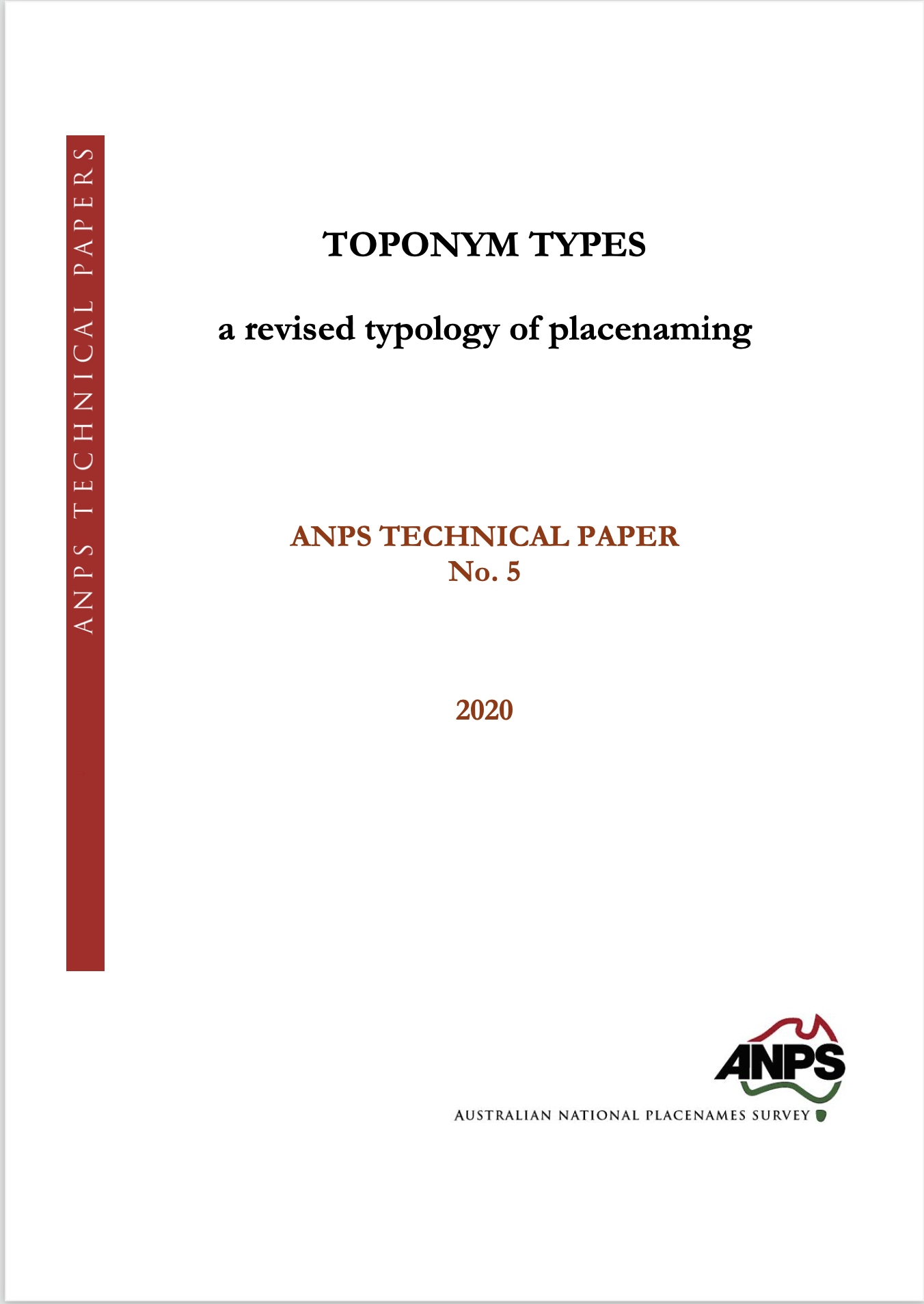 | ANPS Technical Paper No 5: Toponym types: a revised typology of placenaming (2020), by David Blair & Jan Tent |
 | ANPS Technical Paper No 6: The feature catalogue of the Australian National Placenames Survey (2024), by David Blair |
Placenames Reports
General Editor: David Blair
This Series presents the results of toponymic work by researchers of the Survey. All the Reports in this Series are based on the principles of ANPS research:
This Series presents the results of toponymic work by researchers of the Survey. All the Reports in this Series are based on the principles of ANPS research:
- documentation for each placename is recorded,
- an interpretation of the placename's origin and history is formed,
- and the 'story' of the placenames is presented in an accessible form.
 | ANPS Placenames Report No 1: James Cook's toponyms: Placenames of eastern Australia, April-August 1770 (2014; 2017), by David Blair |
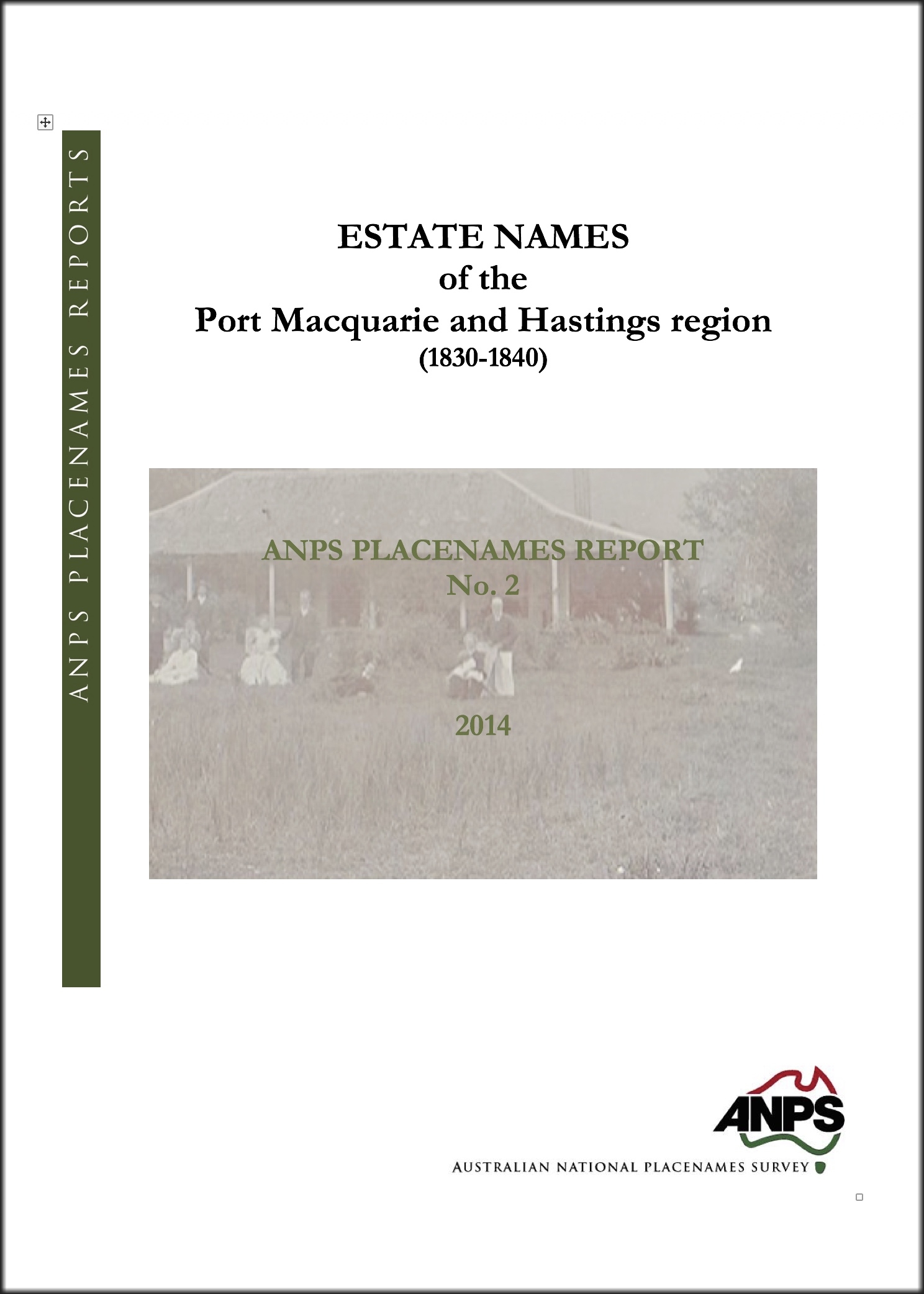 | ANPS Placenames Report No 2: Estate names of the Port Macquarie & Hastings region, 1830-1840 (2014), by Tony Dawson |
 | ANPS Placenames Report No 3: Lord Howe Island (2015), by David Blair |
Data Reports
General Editor: David Blair
The Survey releases, from time to time, records of toponymic data which have been prepared by our researchers. Although the data may not be in the final form which ANPS requires of its Placenames Reports, it may still be found useful and interesting by those whose interests extend to the placenames of the particular locality.
The Survey releases, from time to time, records of toponymic data which have been prepared by our researchers. Although the data may not be in the final form which ANPS requires of its Placenames Reports, it may still be found useful and interesting by those whose interests extend to the placenames of the particular locality.
 | ANPS Data Report No 1: Norfolk Island [2016], by Joshua Nash |
 | ANPS Data Report No 2: Dudley Peninsula [2016], by Joshua Nash |
 | ANPS Data Report No 3: Hornsby Shire 1886-1906 [2019], by Hornsby Shire Historical Society |
 | ANPS Data Report No 4: Placenames of Western Australia from 19th Century Exploration [2016], by Lesley Brooker |
 | ANPS Data Report No 5: Ocean Beach Names: Newcastle-Sydney-Wollongong [2016], by David Blair |
 | ANPS Data Report No 6: Darling Downs: Natural Features and Pastoral Runs 1827-1859 [2002/2017], by Dale Lehner |
 | ANPS Data Report No 7: Ocean Beach Names: Northern NSW - Tweed to Hunter [2017], by David Blair |
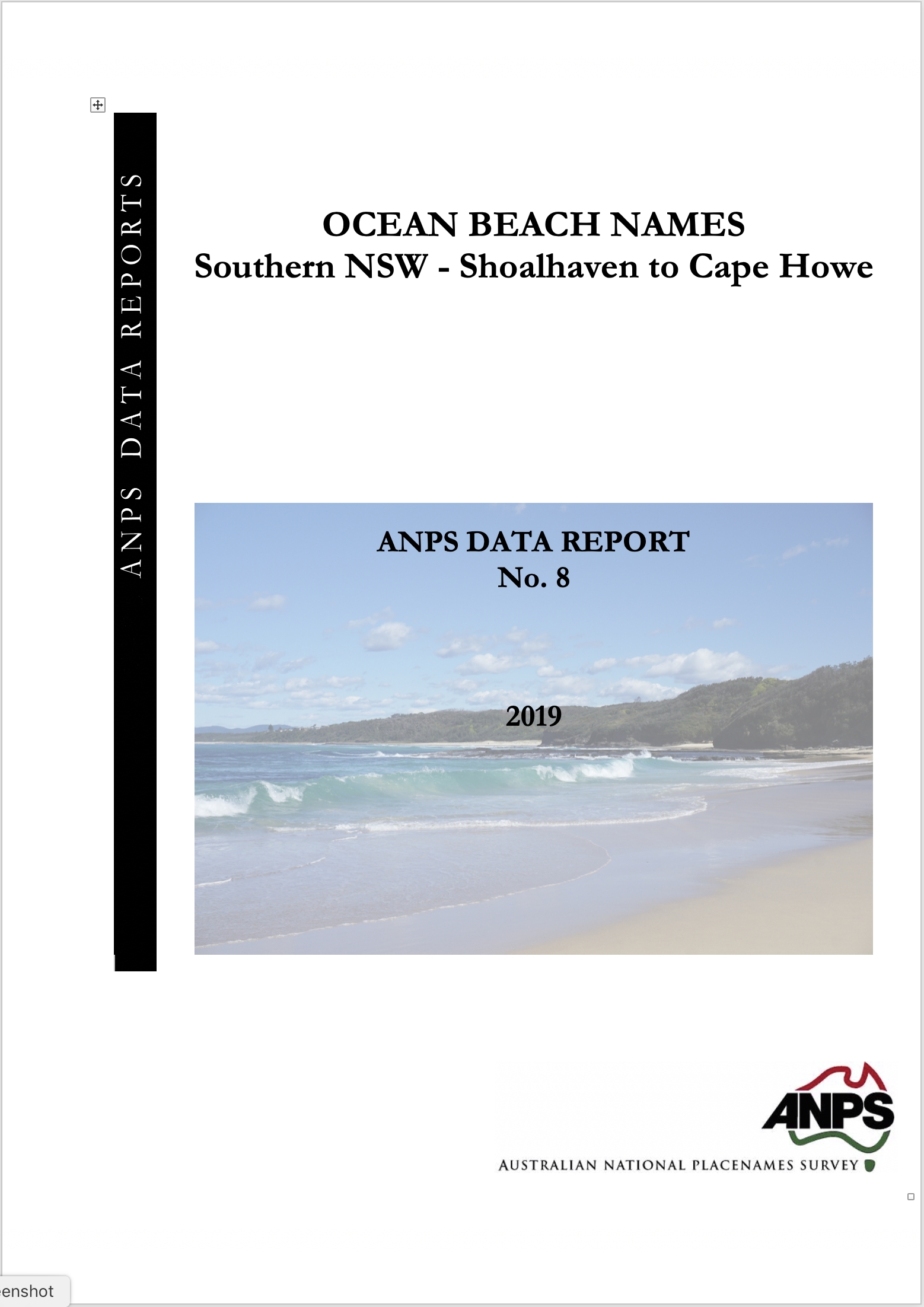 | ANPS Data Report No 8: Ocean Beach Names: Southern NSW - Shoalhaven to Cape Howe [2019], by David Blair |
Occasional Papers
General Editor: David Blair
This Series presents papers of toponymic interest written by researchers associated with the Survey. The papers are too substantial to find their place within the pages of the newsletter Placenames Australia, but are of general interest and may indeed have been written as a response to issues raised in that publication.
In preparation:
- 17. Australia's toponymic links with the Pacific | 18. Australia's micronation names


This Series presents papers of toponymic interest written by researchers associated with the Survey. The papers are too substantial to find their place within the pages of the newsletter Placenames Australia, but are of general interest and may indeed have been written as a response to issues raised in that publication.
 | ANPS Occasional Paper No 1: Trunketabella: 'pretty trinkets'? (December 2015), by Jeremy Steele |
 | ANPS Occasional Paper No 2: The early names of Australia's coastal regions (May 2017), by Jan Tent |
 | ANPS Occasional Paper No 3: The naming of Irvingdale and Mt Irving (July 2018), by Diana Beal |
 | ANPS Occasional Paper No 4 The Cogie: the case of a conflated name? (September 2018), by Jan Tent |
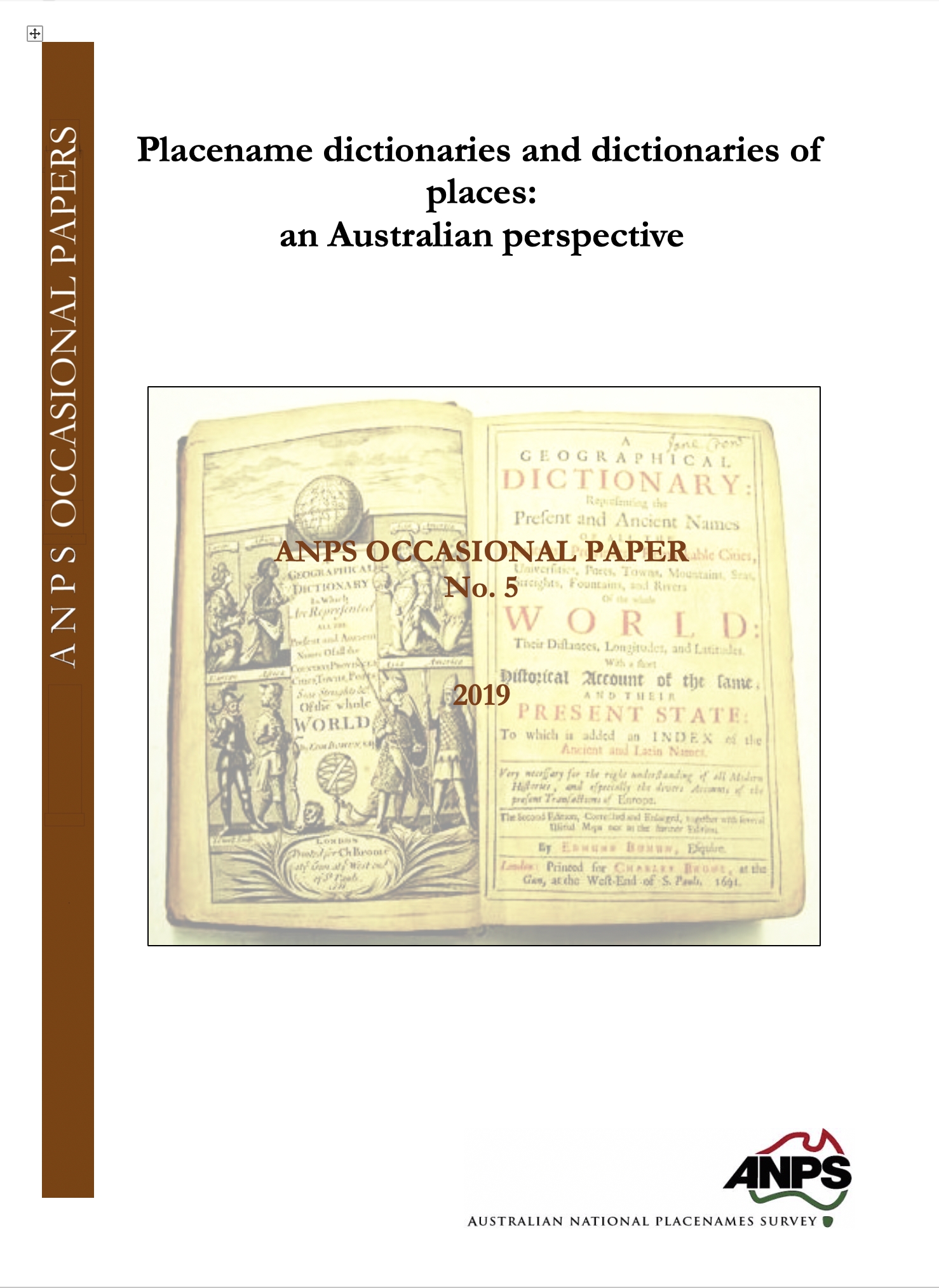 | ANPS Occasional Paper No 5 Placename dictionaries and dictionaries of places: an Australian perspective (January 2019), by Jan Tent |
 | ANPS Occasional Paper No 6 On the scent of Coogee? (April 2019), by Jan Tent |
 | ANPS Occasional Paper No 7 The uncertain origin of Brooklyn in the Antipodes (September 2019), by Jan Tent |
 | ANPS Occasional Paper No 8 Kangarooby: the case of a hybrid toponym (March 2020), by Jan Tent |
 | ANPS Occasional Paper No 9 The 'Sugarloaf' (April 2020), by Jan Tent |
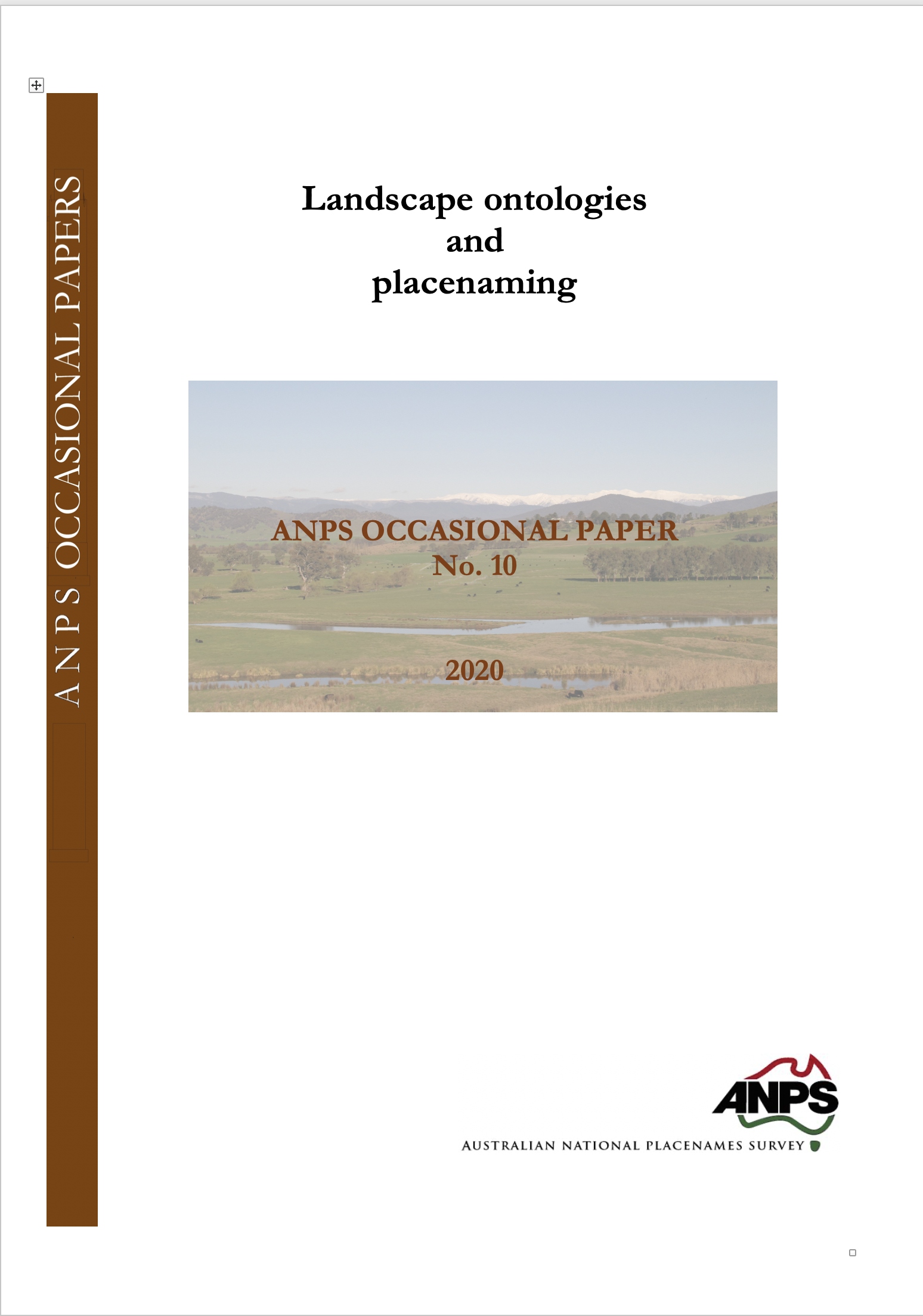 | ANPS Occasional Paper No 10 Landscape ontologies and placenaming (June 2020), by Jan Tent |
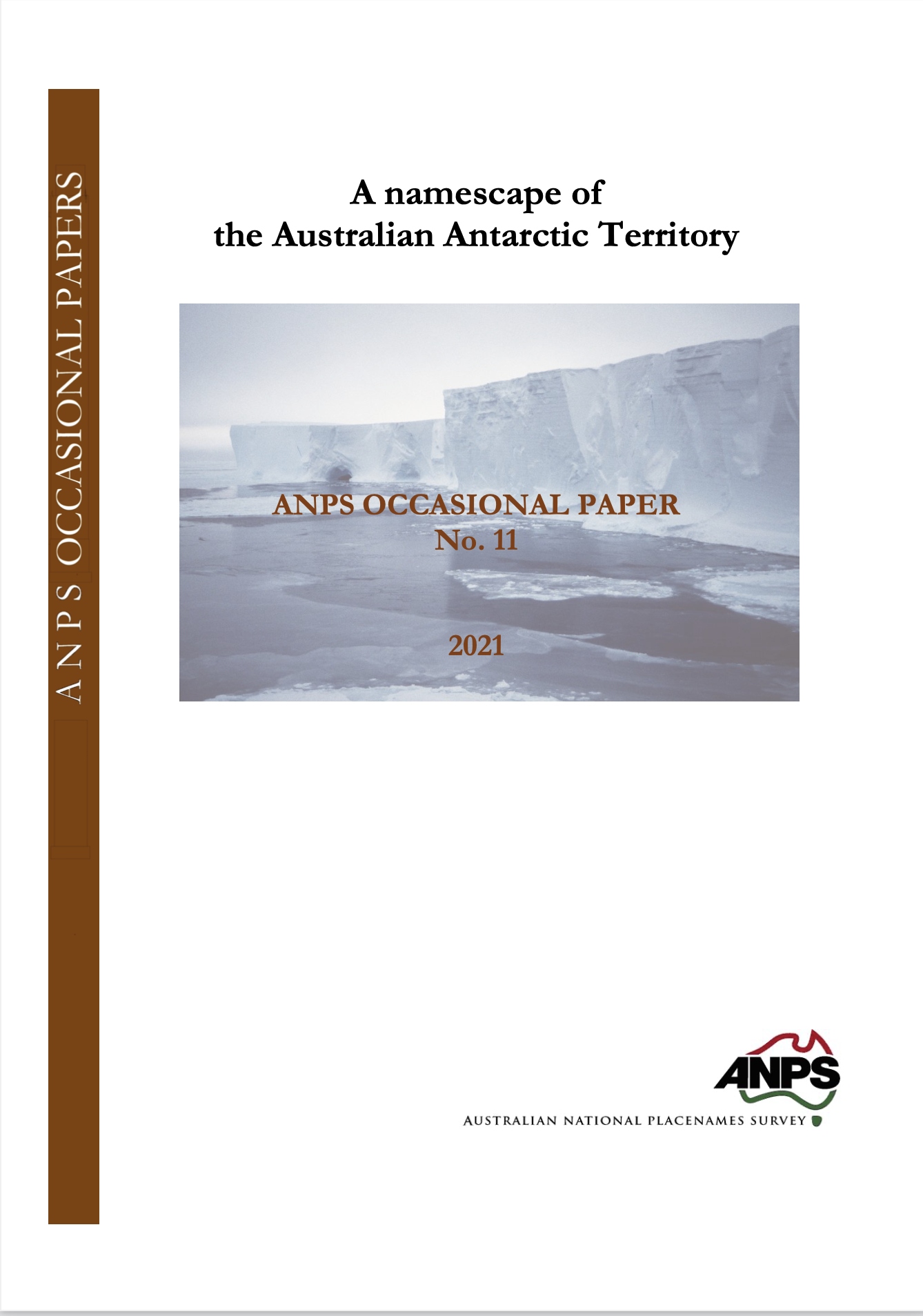 | ANPS Occasional Paper No 11 A namescape of the Australian Antarctic Territory (April 2021), by Jan Tent |
 | ANPS Occasional Paper No 12 A dance of brolgas? The meaning of Taralga (March 2022), by Peter McInnes |
 | ANPS Occasional Paper No 13 Who named New Holland? (October 2022), by Jan Tent |
 | ANPS Occasional Paper No 14 Who named Groote Eylandt? (November 2022), by Jan Tent |
 | ANPS Occasional Paper No 15 A southeastern Dog Country (May 2023), by Jim Wafer and Tracey Howie |
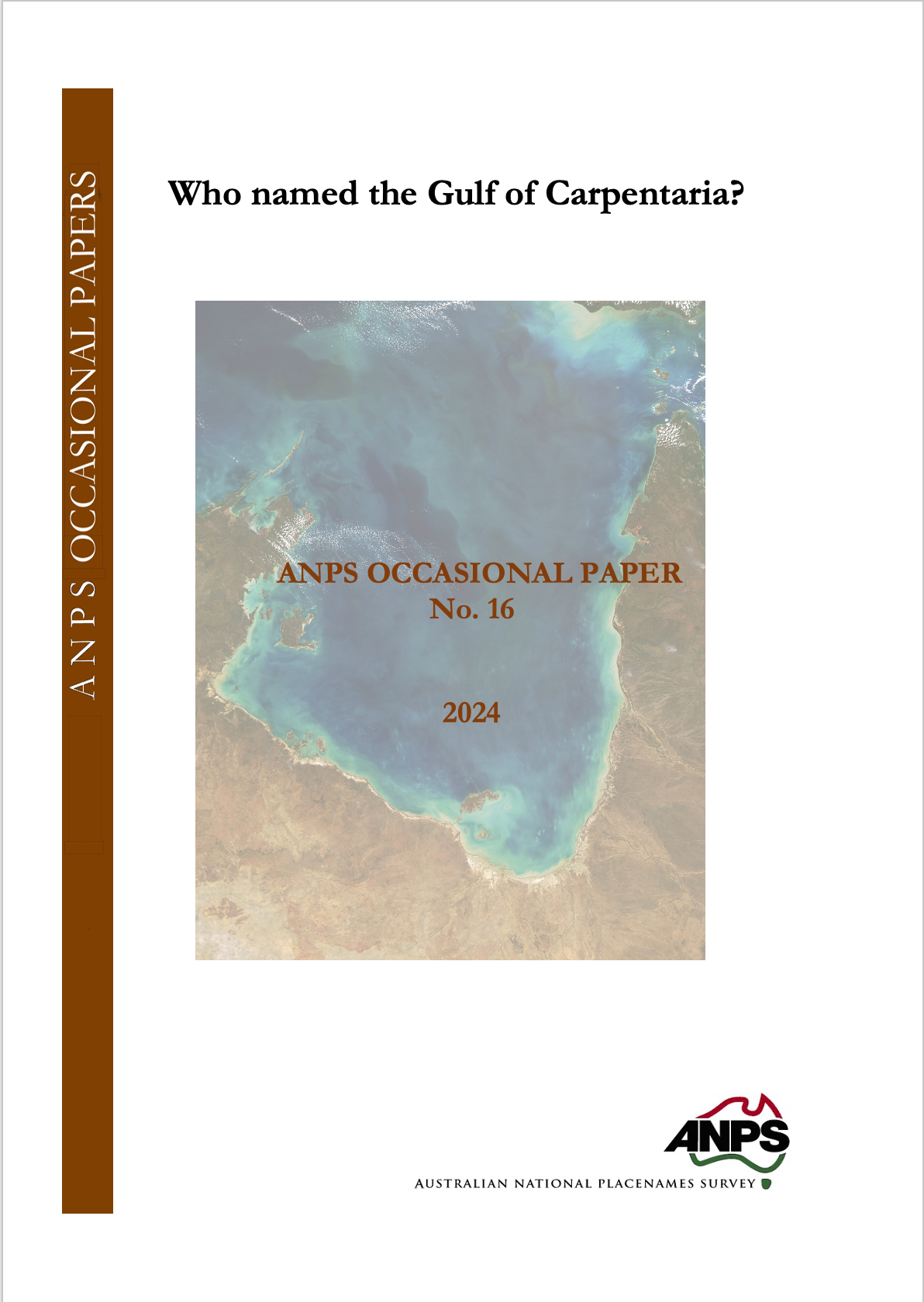 | ANPS Occasional Paper No 16 Who named the Gulf of Carpentaria? (September 2024), by Jan Tent |
In preparation:
- 17. Australia's toponymic links with the Pacific | 18. Australia's micronation names

